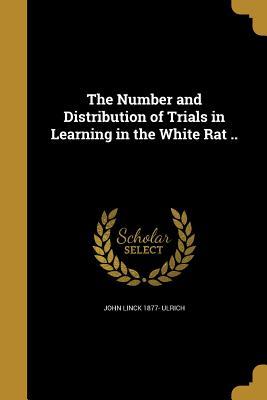Full Download The Number and Distribution of Trials in Learning in the White Rat .. - John Linck 1877- Ulrich file in ePub
Related searches:
Number of higher probabilities and relations with the number of trials?
The Number and Distribution of Trials in Learning in the White Rat ..
On the Distribution of the Number of Successes in Independent Trials
The Probability Distribution for the Number of Successes in
The Distribution of the Number of Successes in a - JSTOR
Find Variance and Number of Trials for Binomial Distribution
The Binomial Distribution
The [Standard] Normal Distribution - Andrews University
A Distribution-based Method for Assessing The Differences between
Section 6.2: The Binomial Probability Distribution
The Binomial Distribution - Learn
Number of Trials to First Success - Cut the Knot
Student: when i was looking at the normal distribution and the skewed distribution activities, i noticed that the histograms never looked much like the curves.
For the binomial distribution, we want to find the number of successes in n independent trials, given that we know the probability of success for any individual.
Clinical trials are the gold standard for generating new high-quality medical evidence. Each clinical trial has three populations: the real-world patient population,.
The probability distribution, which tells us which values a variable takes, and in binomial random experiments, the number of successes in n trials is random.
A binomial experiment has four characteristics: the experiment is repeated a fixed number of times called n, these are called observations or trials.
Some cases, the number of repeated trials is fixed in advance and we are interested the probability distribution of x is called a binomial distribution.
Public health officials might want to find the mean of this distribution.
The binomial distribution the experiment consists of n identical trials. Each trial results in one of the two outcomes, called success and failure.
If s successes occur in n trials there will be a number of changes from success on one trial.
Q indicates the probability of failure (not success) for any one trial. P(x) indicate the probability of getting exactly x successes in n trials.
The number of successes s in n independent trials is one of the classic distributions in statistics.
This is a binomial experiment since it meets all three characteristics. There are only two outcomes, a head or a tail, of each trial.
13 mar 2016 does the numbers of trials are not related to the percentages of probabilities another relevant topic is probability distribution functions (pdf).
The binomial probability distribution is the theoretical probability distribution of all numbers of possible successes over a certain number of bernoulli trials.
Criteria for a binomial probability experiment a fixed number of trials each trial is independent of the others there are only two outcomes the probability of each.
Poisson� returns the value of the poisson distribution function (or poisson cumulative distribution function).
For example counting the number of defective items produced by a machine might be thought of as counting successes if you are looking for defective items! trials.
Glossary there are one or more bernoulli trials with all failures except the last one, which is a success.
In a binomial distribution the probabilities of interest are those of receiving a certain number of successes, r, in n independent trials each having.
In this example we saw that, in the first 1172 weeks of the lottery the number 38 if we run this binomial distribution in agenarisk and enter the number of trials.
Let x be the discrete random variable whose value is the number of successes in n trials. Then the probability distribution function for x is called the binomial.
28 nov 2016 find variance and number of trials for binomial distribution.
The binomial distribution is the sum of a series of multiple independent and identically distributed bernoulli trials.
( the outcome of any individual trial doesn't affect the probabilities in the other.
Informally, the probability of an event is the average number of times the event occurs in a sequence of trials.
There are only two possible outcomes, called “success” and “failure,” for each trial.
Binomial distribution is used for calculating the probability of exact number of successes for a given number of trials.
Random variable that reports the number x successes in n trials. Each trial is a bernoulli trial which satisfies a) there are only two outcomes for each trial.
September, 1956 on the distribution of the number of successes in independent trials.

Post Your Comments: